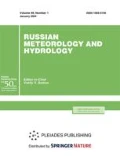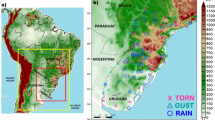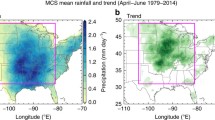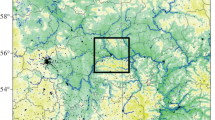Abstract
Changes in the frequency and intensity of atmospheric severe convective events, including heavy rainfall, thunderstorm, hailstorm, squall, and tornado, in the Russian regions during the warm season are analyzed using different independent sources of information. Based on observations at Russian weather stations in 1966–2020, the frequency of thunderstorm, hailstorm, and strong wind, the contribution of extreme showers to total precipitation, and the cumulonimbus cloud fraction are estimated. Based on satellite data, the frequency and intensity of tornado and squall events that caused windthrows for 1986–2021 and the height of the top of deep convective clouds for 2002–2021 are also evaluated. The ERA5 reanalysis data are used to analyze the frequency of conditions favorable for the development of moderate and intense severe convective events in 1979–2020. The results indicate a general intensification of severe convective events in most Russian regions, except for a number of regions in the south of the European part of Russia. The frequency of moderate hazards has a decreasing trend, and the frequency of the most intense severe hazards has an increasing trend. It is reasonable to take the results into account when developing plans for the adaptation of Russian regions and industries to climate change.




Similar content being viewed by others
REFERENCES
A. A. Alekseeva, “Methods to Estimate Maximum Convective Velocity for the Diagnosis and Forecasting of Severe Convective Weather Events,” Gidrometeorologicheskie Issledovaniya i Prognozy, No. 376 (2020) [in Russian].
M. A. Aleshina, P. A. Toropov, and V. A. Semenov, “Temperature and Humidity Regime Changes on the Black Sea Coast in 1982–2014,” Meteorol. Gidrol., No. 4 (2018) [Russ. Meteorol. Hydrol., No. 4, 43 (2018)].
M. A. Aleshina, V. A. Semenov, and A. V. Chernokulsky, “Studying the Role of Global and Regional Factors in Changing the Extreme Summer Precipitation on the Caucasus Black Sea Coast Using Climate Model Experiments,” Fundamental’naya i Prikladnaya Klimatologiya, No. 3 (2019) [in Russian].
O. N. Bulygina, V. M. Veselov, T. M. Aleksandrova, and N. N. Korshunova, Atmospheric Phenomena at Russian Weather Stations (Current). The State Registration Certificate No. 2015620081 (2014) [in Russian].
N. E. Veremei, Yu. A. Dovgalyuk, S. V. Efimov, A. M. Nosova, and A. A. Pechenkin, “Studying the Showers and Thunderstorms on the Territory of Russia Using the Numerical Model of Convective Cloud and the Reanalysis Data,” Meteorol. Gidrol., No. 1 (2013) [Russ. Meteorol. Hydrol., No. 1, 38 (2013)].
V. P. Gorbatenko, I. V. Kuzhevskaya, K. N. Pustovalov, V. V. Chursin, and D. A. Konstantinova, “Assessment of Atmospheric Convective Potential Variability in Western Siberia in Changing Climate,” Meteorol. Gidrol., No. 5 (2020) [Russ. Meteorol. Hydrol., No. 5, 45 (2020)].
I. M. Gubenko and K. G. Rubinshtein, “Analysis of the Results of Thunderstorm Forecasting Based on Atmospheric Instability Indices Using the WRF-ARW Numerical Model Data,” Meteorol. Gidrol., No. 1 (2015) [Russ. Meteorol. Hydrol., No. 1, 40 (2015)].
Report on Climate Features in the Russian Federation in 2019 (Roshydromet, Moscow, 2020) [in Russian].
Report on Climate Features in the Russian Federation in 2020 (Roshydromet, Moscow, 2021) [in Russian].
Report on Climate Risks in the Russian Federation (Roshydromet, Moscow, 2017) [in Russian].
A. V. Eliseev, I. I. Mokhov, and A. V. Chernokulsky, “The Influence of Lightning Activity and Anthropogenic Factors on Large-Scale Characteristics of Natural Fires,” Izv. Akad. Nauk, Fiz. Atmos. Okeana, No. 1, 53 (2017) [Izv., Atmos. Oceanic Phys., No. 1, 53 (2017)].
O. G. Zolina and O. N. Bulygina, “Current Climatic Variability of Extreme Precipitation in Russia,” Fundamental’naya i Prikladnaya Klimatologiya, No. 1 (2016) [in Russian].
A. I. Kobzar’, Applied Mathematic Statistics for Engineers and Researchers (Fizmatlit, Moscow, 2006) [in Russian].
L. F. Kozlova and A. M Sterin, “Studying Long-term Variability of Tropopause Parameters over the Russian Federation from Radiosonde Data,” Trudy VNIIGMI-MTsD, No. 178 (2014) [in Russian].
A. A. Korshunov, V. M. Shaimardanov, M. Z. Shaimardanov, and S. I. Shamin, “Frequency of Hydrometeorological Hazards Which Caused Socioeconomic Damage in 1998–2017,” Meteorol. Gidrol., No. 11 (2019) [in Russian].
M. V. Kurgansky, A. V. Chernokulsky, and I. I. Mokhov, “The Tornado over Khanty-Mansiysk: An Exception or a Symptom?”, Meteorol. Gidrol., No. 8 (2013) [Russ. Meteorol. Hydrol., No. 8, 38 (2013)].
I. I. Mokhov, “Climate Change: Causes, Risks, Consequences, and Problems of Adaptation and Regulation,” Vestnik RAS, No. 1, 92 (2022) [Her. Russ. Acad. Sci., No. 1, 92 (2022)].
I. I. Mokhov and M. G. Akperov, “Tropospheric Lapse Rate and Its Relation to Surface Temperature from Reanalysis Data,” Izv. Akad. Nauk, Fiz. Atmos. Okeana, No. 4, 42 (2006) [Izv., Atmos. Oceanic Phys., No. 4, 42 (2006)].
I. I. Mokhov, A. V. Chernokulsky, M. G. Akperov, J.-L. Dufresne, and H. Le Treut, “Variations in the Characteristics of Cyclonic Activity and Cloudiness in the Atmosphere of Extratropical Latitudes of the Northern Hemisphere Based from Model Calculations Compared with the Data of Reanalysis and Satellite Data,” Dokl. Akad. Nauk, No. 3, 424 (2009) [Dokl. Earth. Sci., No. 1, 424 (2009)].
K. N. Pustovalov, V. P. Gorbatenko, P. V. Nagorskii, and O. E. Nechepurenko, “Spatial and Temporal Variability of Convective Instability in the South of Western Siberia According to ERA5 Reanalysis Data,” Vestnik KRAUNTs. Fiz.-mat. Nauki, No. 4, 37 (2021) [in Russian].
M. L. Toropova and I. N. Rusin, “Simulation of Atmospheric Stratification to Predict Convective Phenomena Using the WRF-ARW Model,” Trudy GGO, No. 593 (2019) [in Russian].
E. I. Khlebnikova, Yu. L. Rudakova, and I. M. Shkolnik, “Changes in Precipitation Regime over the Territory of Russia: Data of Regional Climate Modeling and Observations,” Meteorol. Gidrol., No. 7 (2019) [Russ. Meteorol. Hydrol., No. 7, 44 (2019)].
A. V. Chernokulsky, F. A. Kozlov, O. G. Zolina, O. N. Bulygina, and V. A. Semenov, “Climatology of Precipitation of Different Genesis in Northern Eurasia,” Meteorol. Gidrol., No. 7 (2018) [Russ. Meteorol. Hydrol., No. 7, 43 (2018)].
A. V. Chernokulsky, M. V. Kurgansky, and I. I. Mokhov, “Analysis of Changes in Tornadogenesis Conditions over Northern Eurasia Based on a Simple Index of Atmospheric Convective Instability,” Dokl. Akad. Nauk, 477 (2017) [Dokl. Earth Sci., No. 2, 477 (2017)].
A. V. Chernokulsky, M. V. Kurgansky, I. I. Mokhov, A. N. Shikhov, I. O. Azhigov, E. V. Selezneva, D. I. Zakharchenko, B. Antonescu, and T. Kuhne, “Tornadoes in the Russian Regions,” Meteorol. Gidrol., No. 2 (2021) [Russ. Meteorol. Hydrol., No. 2, 46 (2021)].
A. B. Chochaev and Yu. P. Mikhailovskii, “Analysis of Development and Interaction of Cells in Thunderstorms with Hail,” Trudy GGO, No. 586 (2017) [in Russian].
N. V. Shvets’, “Precipitation Intensity: Measurement Methods, Observation Databases, Use of Precipitation Intensity Data in Climate Research and Applied Problems,” Trudy VNIIGMI-MTsD, No. 186 (2020) [in Russian].
M. A. Aleshina, V. A. Semenov, and A. V. Chernokulsky, “A Link between Surface Air Temperature and Extreme Precipitation over Russia from Station and Reanalysis Data,” Environ. Res. Lett., 16 (2021).
B. A. Baum, W. P. Menzel, R. A. Frey, D. Tobin, R. Holz, S. Ackerman, A. Heidinger, and P. Yang, “MODIS Cloud-top Property Refinements for Collection 6,” J. Appl. Meteorol. Climatol., 51 (2012).
H. E. Brooks, C. A. Doswell III, X. Zhang, A. Chernokulsky, E. Tochimoto, B. Hanstrum, E. de Lima Nascimento, D. Sills, B. Antonescu, and B. Barrett, “A Century of Progress in Severe Convective Storm Research and Forecasting,” Meteorol. Monographs, 59 (2019).
B. Chen and Z. Liu, “Global Water Vapor Variability and Trend from the Latest 36-year (1979 to 2014) Data of ECMWF and NCEP Reanalyses, Radiosonde, GPS, and Microwave Satellite,” J. Geophys. Res. Atmos., 121 (2016).
J. Chen, A. Dai, Y. Zhang, and K. L. Rasmussen, “Changes in Convective Available Potential Energy and Convective Inhibition under Global Warming,” J. Climate, 33 (2020).
Q. Chen, J. Fan, Y. Yin, and B. Han, “Aerosol Impacts on Mesoscale Convective Systems Forming under Different Vertical Wind Shear Conditions,” J. Geophys. Res. Atmos., 125 (2020).
R. Cherian and J. Quaas, “Trends in AOD, Clouds, and Cloud Radiative Effects in Satellite Data and CMIP5 and CMIP6 Model Simulations over Aerosol Source Regions,” Geophys. Res. Lett., 47 (2020).
A. Chernokulsky and I. Esau, “Cloud Cover and Cloud Types in the Eurasian Arctic in 1936–2012,” Int. J. Climatol., 39 (2019).
A. Chernokulsky, F. Kozlov, O. Zolina, O. Bulygina, I. Mokhov, and V. Semenov, “Observed Changes in Convective and Stratiform Precipitation in Northern Eurasia over the Last Five Decades,” Environ. Res. Lett., 14 (2019).
A. Chernokulsky, M. Kurgansky, I. Mokhov, A. Shikhov, I. Azhigov, E. Selezneva, D. Zakharchenko, B. Antonescu, and T. Kuhne, “Tornadoes in Northern Eurasia: From the Middle Age to the Information Era,” Mon. Wea. Rev., 148 (2020).
A. Chernokulsky, A. Shikhov, A. P. Bykov, N. Kalinin, M. Kurgansky, B. Sherstyukov, and Yu. I. Yarinich, “Diagnosis and Modelling of Two Destructive Derecho Events in European Russia in the Summer of 2010,” Atmos. Res., 267 (2022).
A. V. Chernokulsky, O. N. Bulygina, and I. I. Mokhov, “Recent Variations of Cloudiness over Russia from Surface Daytime Observations,” Environ. Res. Lett., 6 (2011).
Climate Change 2021: The Physical Science Basis. Contribution of Working Group I to the Sixth Assessment Report of the Intergovernmental Panel on Climate Change, Ed. by V. Masson-Delmotte, P. Zhai, and A. Pirani (Cambridge Univ. Press, 2021).
F. P. Colby, “Convective Inhibition as a Predictor of Convection during AVE-SESAME II,” Mon. Wea. Rev., 112 (1984).
A. Dai, R. M. Rasmussen, C. Liu, K. Ikeda, and A. F. Prein, “A New Mechanism for Warm-season Precipitation Response to Global Warming Based on Convection-permitting Simulations,” Climate Dynamics, 55 (2017).
M. G. Donat, A. L. Lowry, L. V. Alexander, P. A. O’Gorman, and N. Maher, “More Extreme Precipitation in the World’s Dry and Wet Regions,” Nature Climate Change, 6 (2016).
C. A. Doswell III, H. E. Brooks, and R. A. Maddox, “Flash Flood Forecasting: An Ingredients-based Methodology,” Wea. Forecasting, 11 (1996).
C. A. Doswell III and D. M. Schultz, “On the Use of Indices and Parameters in Forecasting Severe Storms,” E-J. of Severe Storms Meteorol., No. 3, 1 (2006).
N. Dotzek and C. Price, “Lightning Characteristics of Extreme Weather Events,” in Lightning Principles, Instruments and Applications, Ed. by H. D. Betz, U. Schumann, and P. Laroche (2009).
R. Eastman and S. G. Warren, “A 39-yr Survey of Cloud Changes from Land Stations Worldwide 1971–2009: Long-term Trends, Relation to Aerosols, and Expansion of the Tropical Belt,” J. Climate, 26 (2013).
B. Gardiner, K. Blennow, J.-M. Carnus, P. Fleischer, and F. Ingermarsson, Destructive Storms in European Forests: Past and Forthcoming Impacts (DG Environment, 2010).
P. Groenemeijer, T. Pucik, A. M. Holzer, B. Antonescu, K. Riemann-Campe, D. Schultz, T. Kuhne, B. Feuerstein, H. Brooks, C. Doswell, H. Koppert, and R. Sausen, “Severe Convective Storms in Europe: Ten Years of Research and Education at the European Severe Storms Laboratory,” Bull. Amer. Meteorol. Soc., 98 (2017).
H. Hersbach, B. Bell, P. Berrisford, S. Hirahara, A. Horanyi, J. Munoz-Sabater, J. Nicolas, C. Peubey, R. Radu, D. Schepers, A. Simmons, C. Soci, S. Abdalla, X. Abellan, G. Balsamo, P. Bechtold, G. Biavati, J. Bidlot, M. Bonavita, G. Chiara, P. Dahlgren, D. Dee, M. Diamantakis, R. Dragani, J. Flemming, R. Forbes, M. Fuentes, A. Geer, L. Haimberger, S. Healy, R. Hogan, E. Holm, M. Janiskova, S. Keeley, P. Laloyaux, P. Lopez, C. Lupu, G. Radnoti, P. Rosnay, I. Rozum, F. Vamborg, S. Villaume, and J. Thepaut, “The ERA5 Global Reanalysis,” Quart. J. Roy. Meteorol. Soc., 146 (2020).
R. H. Holzworth, J. B. Brundell, M. P. McCarthy, A. Jacobson, C. Rodger, and T. Anderson, “Lightning in the Arctic,” Geophys. Res. Lett., 48 (2021).
M. B. Kireeva, E. P. Rets, N. L. Frolova, T. Samsonov, E. S. Povalishnikova, A. Entin, I. Durmanov, and A. M. Ivanov, “Occasional Floods on the Rivers of Russian Plain in the 20th–21st Centuries,” Geography, Environment, Sustainability, No. 2, 13 (2020).
C. Lepore, R. Abernathey, N. Henderson, J. T. Allen, and M. K. Tippett, “Future Global Convective Environments in CMIP6 Models,” Earth’s Future, 9 (2021).
E. P. Meredith, V. A. Semenov, D. Maraun, W. Park, and A. V. Chernokulsky, “Crucial Role of Black Sea Warming in Amplifying the 2012 Krymsk Precipitation Extreme,” Nature Geosci., 8 (2015).
M. W. Moncrieff and M. J. Miller, “The Dynamical Structure of Two-dimensional Steady Convection in Constant Vertical Shear,” Quart. J. Roy. Meteorol. Soc., 104 (1976).
A. I. Narizhnaya, A. V. Chernokulsky, M. G. Akperov, D. Chechin, I. Esau, and A. V. Timazhev, “Marine Cold Air Outbreaks in the Russian Arctic: Climatology, Interannual Variability, Dependence on Sea-ice Concentration,” IOP Conference Series: Earth and Environmental Science, No. 1, 606 (2020).
T. Pucik, C. Castellano, P. Groenemeijer, T. Kuhne, A. T. Radler, B. Antonescu, and E. Faust, “Large Hail Incidence and Its Economic and Societal Impacts across Europe,” Mon. Wea. Rev., 147 (2019).
T. Pucik, P. Groenemeijer, and A. T. Radler, “Future Changes in European Severe Convection Environments in a Regional Climate Model Ensemble,” J. Climate, 30 (2017).
K. L. Rasmussen, A. F. Prein, R. M. Rasmussen, K. Ikeda, and C. Liu, “Changes in the Convective Population and Thermodynamic Environments in Convection-permitting Regional Climate Simulations over the United States,” Climate Dynamics, 55 (2020).
T. H. Raupach, O. Martius, J. Allen, M. Kunz, S. Lasher-Trapp, S. Mohr, K. Rasmussen, R. Trapp, and Q. Zhang, “The Effects of Climate Change on Hailstorms,” Nature Reviews Earth & Environment, 2 (2021).
N. N. Ridder, A. M. Ukkola, A. J. Pitman, and S. E. Perkins-Kirkpatrick, “Increased Occurrence of High Impact Compound Events under Climate Change,” J. Climate and Atmos. Sci., No. 3, 5 (2022).
D. M. Romps, J. T. Seeley, D. Vollaro, and J. Molinari, “Projected Increase in Lightning Strikes in the United States due to Global Warming,” Science, 346 (2014).
A. Shikhov and A. Chernokulsky, “A Satellite-derived Climatology of Unreported Tornadoes in Forested Regions of Northeast Europe,” Remote Sens. Environ., 204 (2018).
A. Shikhov, A. Chernokulsky, N. Kalinin, A. Bykov, and E. Pischalnikova, “Climatology and Formation Environments of Severe Convective Windstorms and Tornadoes in the Perm Region (Russia) in 1984–2020,” Atmosphere, No. 11, 12 (2021).
A. N. Shikhov, A. V. Chernokulsky, I. Azhigov, and A. Semakina, “A Satellite-derived Database for Stand-replacing Windthrow Events in Boreal Forests of European Russia in 1986–2017,” Earth Syst. Sci. Data, 12 (2020).
M. F. Stuecker, C. M. Bitz, K. C. Armour, C. Proistosescu, S. M. Kang, S. Xie, D. Kim, S. McGregor, W. Zhang, S. Zhao, W. Cai, Y. Dong, and F. Jin, “Polar Amplification Dominated by Local Forcing and Feedbacks,” Nature Climate Change, 8 (2018).
L. Tarabukina and V. Kozlov, “Seasonal Variability of Lightning Activity in Yakutia in 2009–2019,” Atmosphere, No. 9, 11 (2020).
M. Taszarek, J. T. Allen, H. E. Brooks, N. Pilguj, and B. Czernecki, “Differing Trends in United States and European Severe Thunderstorm Environments in a Warming Climate,” Bull. Amer. Meteorol. Soc., 102 (2021).
M. Taszarek, J. T. Allen, T. Pucik, K. A. Hoogewind, and H. E. Brooks, “Severe Convective Storms across Europe and the United States. Part II: ERA5 Environments Associated with Lightning, Large Hail, Severe Wind, and Tornadoes,” J. Climate, 33 (2020).
M. Taszarek, H. E. Brooks, and B. Czernecki, “Sounding-derived Parameters Associated with Convective Hazards in Europe,” Mon. Wea. Rev., 145 (2017).
K. E. Trenberth, A. Dai, R. M. Rasmussen, and D. B. Parsons, “The Changing Character of Precipitation,” Bull. Amer. Meteorol. Soc., 84 (2003).
T. Ushio, S. J. Heckman, D. J. Boccipio, and H. J. Christian, “A Survey of Thunderstorm Flash Rates Compared to Cloud Top Height Using TRMM Satellite Data,” J. Geophys. Res., 106 (2001).
T. Xian and C. R. Homeyer, “Global Tropopause Altitudes in Radiosondes and Reanalyses,” Atmos. Chem. Phys., 19 (2019).
Y. I. Yarinich, A. V. Chernokulsky, V. A. Semenov, and M. Latif, “Role of Sea Surface Warming in Convective Activity over Europe and Northern Eurasia: Estimates with Sensitivity Model Experiments,” IOP Conference Series: Earth and Environmental Science, No. 1, 386 (2019).
O. Zolina, C. Simmer, K. Belyaev, S. K. Gulev, and P. Koltermann, “Changes in the Duration of European Wet and Dry Spells during the Last 60 Years,” J. Climate, 26 (2013).
Author information
Authors and Affiliations
Corresponding author
Additional information
Translated from Meteorologiya i Gidrologiya, 2022, No. 5, pp. 27-41. https://doi.org/10.52002/0130-2906-2022-5-27-41.
About this article
Cite this article
Chernokulsky, A.V., Eliseev, A.V., Kozlov, F.A. et al. Atmospheric Severe Convective Events in Russia: Changes Observed from Different Data. Russ. Meteorol. Hydrol. 47, 343–354 (2022). https://doi.org/10.3103/S106837392205003X
Received:
Revised:
Accepted:
Published:
Issue Date:
DOI: https://doi.org/10.3103/S106837392205003X




